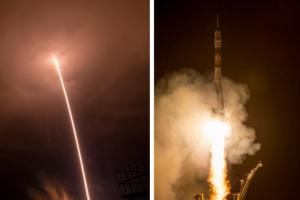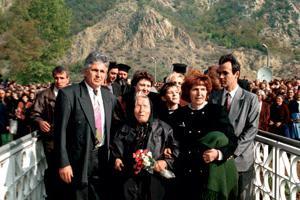Now I’ve once again started talking actively about the HSR - the high-speed (rail) line Moscow-Kazan. Apparently, active development of the project has begun. Well, no one has seen the project yet (only rough sketches), I think there will be specifics soon, but for now I’m interested in another question - what are the speeds there in general and how are things going with train speeds in general. Well, that is, let’s say there is Sapsan - a fairly fast electric train (the essence is an electric train), but it is not classified as high-speed. And there is the “Nevsky Express” - an ordinary train with passenger carriages, driven by a locomotive that travels the route from Moscow to St. Petersburg a little slower than Sapsan...
In short, for me personally, the speed of the train was some unknown number, despite the fact that, as a rule, the trains move exactly according to the schedule (there are minor deviations, of course, but for the most part everything is on time, and even if I fell behind somewhere, they can catch up later). In short, I wanted to figure out how things are going with the real speed of trains (and what prospects there are in general).

Perhaps we should start with the fact that in the characteristics of locomotives/(electric) trains two numbers are usually indicated: design speed and long-term speed (less often, hourly speed). The first is, roughly speaking, the speed, the maximum permissible without compromising operation (in theory, it is probably possible to accelerate faster, but the impact on engines, on rails, etc. is greater - in short, they try not to raise it higher, so as not to violate operating conditions). The second one is a little more difficult. Roughly speaking, continuous duty speed is the indicator at which electric motors can operate most efficiently long time(the minimum speed at which you can ride for a long time at maximum traction position). In short, both numbers are essentially technical, having an indirect relationship to reality.

If we talk about locomotives/trains from a practical point of view: getting from point A to point B, then it would be more correct to talk about commercial speed (it is also called route speed or average daily speed). Generally speaking, it is different for each train, for example, two trains with different commercial speeds can have the same traction locomotives, the same cars and run along the same track (by the way, this speed is affected by stops along the way). For example, we travel from Saratov to Moscow on train No. 009, and we cover the 865-kilometer journey in 14 hours 35 minutes (we get average speed approximately 59 km/h). If we leave a little later, on train No. 017, we will cover the same route in 15 hours 26 minutes, and the speed will already be 56 km/h. At the same time, the cars are the same, the traction locomotives are the same (4 different locomotives from Saratov to Moscow).
Actually, based on their speed, all trains can be divided into the following groups:
- passenger (route speed less than 50 km/h)
- passenger ambulances (route speed not lower than 50 km/h)
- high-speed passenger (route speed not lower than 100 km/h with permissible speeds in the range of 141-200 km/h;)

That is, both the 9th and 17th trains, by all indications, are fast, although they do not move much faster than passenger trains, and the locomotives driving these trains allow them to move at speeds close to high-speed ones. Technically, as I understand it, nothing prevents us from abandoning slow passenger ones and switching to fast ones (and actively developing into high-speed ones). Now the locomotive fleet is being actively updated, and the cars and rails (with other infrastructure) are no longer the same. The problem, as I understand it, is in the dispatching/schedules of trains, which were compiled back in Soviet times (in the early 80s) to suit the technical capabilities of that time. That is, for good reason, it is necessary to change timetables globally, but this is serious work, so for now they are limited to some individual priority routes (where, by the way, high-speed trains appear), but for the most part they are not touching them yet:

Respectively most of passenger trains plying the expanses of Russia at the moment are either just “trains” or slightly more nimble “fast trains”. Even the ambulances can’t be said to be very fast, but they are much cheaper than traveling by plane and more comfortable than traveling by bus/car (this is of course debatable, but in general the quality of passenger carriages is now improving). By the way, the concept of route speed applies mainly to long-distance trains. There is a large class of commuter trains with frequent stops, small gaps between stations, and where, as a rule, multiple unit rolling stock (MURR) is used - often electric trains, less often motrices). Well, these can also be reached, if desired, from one large city to another (though with less comfort) and much more slowly - according to this classification system, they are more likely to be classified as “trains” (although some sections may fall under the class of “fast”), with that a standard electric train can accelerate to 120-140 km/h without risk.

Nevertheless, if we start talking about “high-speed trains” (that which travels on average more than 100 km/h), then the first thing that comes to mind is electric trains - MVPS (and not only here - the situation is the same in other countries). It turns out that at the moment (high) speed trains are trying to compete not with regular long-distance trains, but with aviation. Usually here they take distances within 1000 km (at least I have heard such a figure more than once). Accordingly, at high speeds over relatively short distances, all these compartments are no longer needed for long trips - you just need comfortable seats (and in such situations, you can seat more people in one carriage). But the main thing is the presence of a large number of motorized axles allows you to have a higher specific power (the ratio of engine power to the mass of the rolling stock), which allows you to obtain high accelerations and high speeds. That is why the development of high-speed railway transport is primarily taking the MVPS route (the essence is “electric trains”):

In the USSR, the topic of high-speed railway transport was not only not given due attention, but the tasks were different and more serious. The first Soviet MVPS - ER200 was developed at the Riga Carriage Works in 1973, then it was tested for a long, long time, but its commercial operation (on the Moscow - Leningrad section) began only in 1984, when it was already obsolete. Perhaps this is all that they were able to implement in practice in the USSR; RVR somehow completely deflated after the collapse of the USSR...
In Russia already in the 90s they began to try to cut their modern project high-speed train, which resulted in the ES-250 (Falcon) - in practice even less successful model(compared to ER200) - things didn’t go further than test drives/tests.
In general, it became clear then that the issue of high-speed (and in the future - high-speed) railways could not be solved on our own - the backlog was too significant, we could probably catch up, but how many years would it take - wouldn’t it be easier to start by trying to use Western experience to reduce backlog.

The first such project in 2009 was "".
This is a German high-speed train Siemens Velaro, adapted for Russian conditions (gauge, weather conditions, etc.) All 16 trains in operation today were built in Germany - in fact, Russia simply purchased the trains. The project caused a lot of controversy and discussion, but as for me it was a very positive experience: constant and intensive commercial operation of high-speed trains began (Siemens Velaro is essentially a high-speed series, but for a number of reasons, which are discussed below, for now it is all high-speed train and Saspan's design speed of 250 km/h are not yet in use).
However, the 4 hours it takes to travel from Moscow to St. Petersburg on Sapsan is in fact faster than the same journey by plane. Yes, the plane flies faster, but due to the peculiarities of the infrastructure (you need to get from the city center to the airport, check in for the flight, wait for the flight, taxi, take-off, landing, back to the city), a train going from center to center here gives a significant gain in time and convenience . In a word, despite active criticism, the project took off.
Almost simultaneously with Sapsan, a similar Russian-Finnish project was launched -. There are already Italian trains Alstom Pendolino and the route St. Petersburg - Helsinki. In general, it is not as popular as Sapsan, but again, it has found its niche and is enjoying some success. Allegro again falls into the class of high-speed trains (407 km in 3 hours 27 minutes).

Since we're talking about high-speed ones, it wouldn't hurt to mention - again, a German development for Russian roads(Siemens Desiro), but if Sapsan were simply purchased, here the trains were purchased with the possibility of local production - now a batch for the Moscow Central Circle is being made at the Ural Locomotives plant with a high percentage of localization.
In general, Swallows are used not only for suburban transport, but also on short intercity routes. The same train traveled from Moscow to St. Petersburg in a little more than five hours, and on other routes it fits into the concept of a “high-speed train.”

Well, of course, high-speed trains are not necessarily multi-unit trains. So let’s say the famous “Nevsky Express” (and before it “Aurora”) is an ordinary train (locomotive + unmotorized carriages, albeit very comfortable), which, however, due to the fast electric locomotive (previously there were ChS200, now EP20) takes 650 to travel kilometers a little more than four hours - a little less than the high-speed Sapsan.

So, for the transition from high-speed to high-speed trains, the trains themselves are not enough. A railway is generally a very complex infrastructure (rails and substrates/embankments for them, contact networks, signaling systems, etc.)
As it turned out during operation, Sapsan, although it can reach a speed of 250 km/h in some sections, but even taking into account all the improvements and modernizations of the road, it cannot go the entire way at that speed (and even more so even faster). Features of the contact network, turning radii, etc. Therefore, at the moment we have what we have as Sapsan, especially since Allegro, with all its excellent speed characteristics, is forced to go much slower than its capabilities (Allegro is generally forced to slow down to 30-40 km/h somewhere on winding roads). And one more problem - since the main line along which the trains move is common (all passenger and freight trains go on the same tracks), then when priority is given to high-speed trains, the remaining trains are forced to stand idle. I always travel to St. Petersburg by train No. 047 (Astrakhan - St. Petersburg) and it stops near St. Petersburg more than an hour"skipping" the Peregrine Falcons.
In general, the Moscow-Kazan high-speed highway project (via the cities of Vladimir, Nizhny Novgorod and Cheboksary) first of all implies the construction of a separate highway of a new type - nothing like this has ever been done in Russia (it is already clear that Chinese experience will be used - the Chinese are now generally leaders in world on high-speed rail construction). Of course, there will be special trains for this line with the ability to reach speeds of 300-400 km/h, still unknown - I assume that since Germany has also joined the project, with a high degree of probability we can say that this will be the next incarnation of Siemens Velaro. However, now one of the requirements is already known for sure - the production of trains for high-speed lines from start to finish in Russia, design with the participation of Russian engineers and a high percentage of localization - yes, this is not yet a completely own project, but this is a gradual catching up, and then we will see how will develop...
(the map that caught my eye is no longer relevant, the dates have been shifted, but the approximate direction of development can be assessed):

Well, at the same time, a few words about freight trains and their speeds. Of course, there are no longer any MPVs here - traction locomotives and a bunch of cars (80-120 cars in a train is the norm). When indicating the characteristics of locomotives, the same characteristics are found - design speed, long-duty speed (for the most popular VL80 on the Volga Railway, these figures are 110 km/h and 56 km/h, respectively). Since passenger trains have priority when moving along the railway, freight trains spend a lot of time at stops and sorting stations - waiting for their turn to move on.

It’s difficult to find real numbers, but a couple of years ago (I don’t think the situation has changed significantly now) I came across the following quote:
The average route speed of regular freight trains in Russia now exceeds 630 kilometers per day, container trains - about 900 kilometers, and these figures are growing at a rate of 3 percent per month. On the Trans-Siberian Railway, the speed of freight trains exceeds 1,120 kilometers per day, and this figure is growing at a rate of 7 percent per year.
At the same time, in terms of freight traffic, Russia ranks second in the world after China and is twice as fast as the United States, where, by the way, there is practically no passenger rail transportation. These are quite difficult conditions The local speed of freight trains in Russia is 9 percent higher than in the United States and 10 percent higher than in China.
As we see, even on the most demonstrative sections, freight trains do not yet even approach the speeds of fast passenger trains (although they are already approaching). Meanwhile, such indicators are very good even by world standards. So you shouldn’t be surprised at the overwhelming majority of old freight locomotives - they are coping with their task so far (and now, apparently, a consistent replacement with new ones is beginning). We are clearly not in danger of switching to high-speed freight routes in the coming decades!

Trains are in a hurry, but not at all to the dustbin of history - on the contrary, every year they become more convenient, quieter and faster. How maintenance works modern means public transport, Discovery Channel viewers will be able to find out in the project “Mega Pit Stops”, which airs on Saturdays at 11:00 (one of the episodes of the project is dedicated to the Russian “Sapsan” - you can watch it on May 18), and “Popular Mechanics” will tell about the history of the highest speed trains on the planet.
Editorial PM
Express and high speed
The concept of “high-speed train” does not have a generally accepted definition: it is usually said about railway transport, whose speed is on average higher than that of traditional trains: for example, in Russia, trains that reach speeds of 140 km/h and above are recognized as high-speed, and in India In Canada, this threshold is 160 km/h. But with the definition of “high-speed train” everything is much simpler: as a rule, this is the name given to all railway vehicles that can exceed the 200 km/h mark.
By the way, this threshold was taken at the beginning of the twentieth century by an experimental electric car from Siemens & Halske in October 1903, and just three weeks later the electric car from AEG already demonstrated a speed of 210.2 km/h. The first high-speed line (or HSR for short) appeared only in 1964 - it was the Japanese Tokaido Shinkansen line with a length of 515.4 km. The route quickly gained popularity and the costs of building the line were recouped in just seven years. The success of Japan contributed to the development of high-speed rail in many countries, and it continues to this day, and modern high-speed trains are direct confirmation of this.

Japan: Shinkansen trains
Although the name "Shinkansen" is translated from Japanese as "new highway", colloquial speech these trains are more often called “bullet trains”: largely due to their impressive speed - the design speed of many models exceeds 300 km/h - and partly due to appearance zero series, which became the symbol of the Shinkansen.
The Shinkansen Series 0 electric trains were the first vehicles to enter service on the Tokaido Shinkansen Line in 1964. The line was electrified with single-phase alternating current 25 kV with a frequency of 60 Hz, and the wheel sets of all cars were powered by 185 kW traction motors, which provided a maximum speed of 210 km/h (in 1986 it was increased to 220 km/h). This line was built with a 1435 mm gauge, wider than the rest of the network (1067 mm). Thus, it cannot be used for freight transport or for trains other than shinkansen. The very first representatives of the series included 12, less often 16, cars; after a while they were joined by four- and six-car versions.

In 1982, the next series of electric trains on the Shinkansen network, number 200, entered service (curiously, the 100 series was launched only three years later - the fact is that shinkansen running east of the capital were given numbers of odd hundreds, and to the west - even numbers ): within its framework, modernized trains were later released with speeds from 240 to 275 km/h. In general, over all these years, about 20 different series of these trains have been developed, each of which is distinguished by original design, number of cars, as well as design and technical features. For example, in 300 series trains, electric motors direct current for the first time, three-phase alternating current traction motors replaced the traction motors of the 400 series, the trains of the 400 series have a narrower body, this is due to the fact that the high-speed line on which they ran was converted from a conventional railway line, in the 500 series the maximum service speed of 300 km was achieved for the first time / h, in the N700 series, for the first time among passenger shinkansen, an acceleration of 0.722 m/s² was achieved, and the trains of the E1 and E4 series have two floors.
Shinkansen do not stop developing: in May of this year, the country introduced a new high-speed train Alfa-X, which can accelerate to 360 km/h (this is a record for passenger shinkansen). Its most striking feature is its 22-meter nose, designed to reduce air resistance, which especially increases when such a train enters tunnel sections at high speed. In addition, among technical features series - air brakes and special magnetic plates in the braking system.
Japan: Maglev L0
In addition to high-speed passenger trains, Japan has been experimenting with the development of trains based on the principle of magnetic levitation (maglev for short) since the seventies of the last century. The essence of this technology is that trains move and are controlled by the forces of an electromagnetic field, without touching the surface of the rail during movement - this eliminates friction, thereby increasing the speed of movement.

Since 1972, about 10 different series of maglevs have been created in Japan, and one of the samples of the L0 series, presented to the public in 2012, during tests in 2015 accelerated to 603 km/h, setting an absolute speed record for railway transport (and land passenger transport). transport in general). In 2020, the country is going to release an improved L0 series, which will receive power from the guide path through electromagnetic induction.
It should be noted that so far Japanese maglevs are participating exclusively in experimental launches, but five years ago the country began to build the Chuo Shinkansen maglev line, which will run from Tokyo to Nagoya - the opening of the line is planned for the mid-twenties, and by 2045 they are going to complete it to Osaka.
China: Shanghai Maglev
Today, China ranks first in the world in terms of the length of high-speed railways: by the end of last year, their length reached 29 thousand km - this is approximately two-thirds of the total length of all high-speed railways in the world put into commercial operation - and in 2025 the local the government plans to increase this figure to 38 thousand km. One of the key completed projects in the field of high-speed rail transport is the Shanghai Maglev: the world's fastest magnetic levitation train in commercial operation (speeds up to 431 km/h) and the maglev line of the same name, 30 km long, connecting the Shanghai Longyang metro station Lu and Pudong International Airport. To cover this distance, the train takes only 7 minutes 20 seconds (depending on the train model, the time may increase by 50 seconds).

This ambitious and cutting-edge project, which cost China more than $1 billion, began commercial operation back in 2002, but even today it is still not profitable (annual losses amount to about $93 million). From the very beginning, the Shanghai Maglev was planned not as a viable market solution for the needs of travelers, but as a test project, on the basis of which it was planned to further develop China's railway infrastructure (it appeared before the massive creation of the HSR network in the country), but this idea was later abandoned for several reasons. “Firstly, the construction of such a line itself is extremely expensive. Secondly, from a technical point of view, it is very difficult to build it in real terrain conditions - this requires great technical research and a high engineering level in the country as a whole. Third, Maglev is incredibly difficult and expensive to maintain, especially in environments where the line has great length: if the tracks sag for some reason, in the case of regular and even high-speed railways they can be straightened relatively easily, but in the case of maglev, when the line is supported by a million supports, this becomes very difficult,” explains Pavel Zyuzin, senior researcher at the Center for Research on Transport Problems of Megacities and the Institute of Transport Economics and Transport Policy at the Higher School of Economics. — If, for example, Japan can afford this - there are about 100 million residents concentrated along a narrow strip of settlement between Tokyo, Nagoya and Osaka, forming a corridor with extremely high demand - then this option is not suitable for China. At the same time, recently one of the metro lines there started operating using maglev technology - in this niche in China, magnetic levitation is completely justified and promising.” In general, despite many limiting factors, the expert considers maglev technologies to be the next stage in the development of high-speed rail, while “conventional” high-speed rail transport, in his opinion, has by and large reached the limits of its possible development.
France: TGV series trains
In response to the success of Japan's Shinkansen in the second half of the 20th century, France began building its high-speed trains, the TGV (French for Train à Grande Vitesse). At first, the developers were going to equip the designed trains with gas turbine engines, then with gas engines (this is exactly what the first prototype TGV 001, which appeared in 1972, had - by the way, it managed to set a world speed record among trains without electric traction at 318 km/h). However, due to increased fuel consumption, in the end this idea was also abandoned, and it was decided to build electric trains powered by a contact network. The all-electric Zébulon prototype was completed in 1974, and shortly thereafter the production of the TGV series models and the construction of the LGV lines dedicated to them began, which stands for Ligne à Grande Vitesse, and translates as “high-speed line”.

The first generation TGVs of the Sud-Est series began operating on the first LGV line in 1980 - their initial design speed was 270 km/h, although some of these trains later raised this figure to 300 km/h. The TGV Sud-Est was followed by other train series: TGV La Poste, TGV Atlantique, TGV Réseau, TGV Duplex and Euroduplex, as well as TGV TMST, TGV Thalys PBKA and TGV POS intended for international routes. The last of these series is famous for the world speed record for rail trains of 574.8 km/h, which the electric train TGV POS No. 4402 managed to set in 2007 - however, for this it was somewhat modernized: more powerful traction motors were installed in motor cars, thereby increasing the most output power from 9.3 MW to 19.6 MW, equipped with wheel pairs larger diameter and closed the gaps between the cars for better streamlining.
The design process for the next generation of TGV, called Avelia Horizon, began in 2016. New features include greater capacity to carry up to 740 passengers, improved on-board services and communications, and a 20% reduction in energy consumption through the introduction of regenerative braking, which national rail carrier SNCF says makes the trains "the greenest TGVs yet" in history" (the latter is also supported by the fact that future trains, after decommissioning, can be 97% recycled). Last year, SNCF announced an order for hundreds of such trains, with deliveries due to begin in 2023.
Spain: Talgo 350
“Spain is the first country in Europe to build not a separate route, but an entire network of high-speed lines, which, given the presence of two central air hubs - Barcelona and Madrid - made travel around the country incredibly fast and, among other things, had a positive impact on the development tourism,” says Pavel Zyuzin. Today Spain ranks second in the world in terms of the length of the high-speed railway (2,850 km) - it is logical that high-tech trains run along them.
 Talgo
Talgo
The AVE series 102 (or Talgo 350) trains, jointly produced by Talgo and Bombardier, running between Madrid and Barcelona are perhaps the most famous Spanish trains abroad. The Talgo 350 gained wide fame along with the nickname “Duck” largely due to its original and rather funny design: the nose of the train is elongated and actually somewhat resembles a duck’s - this was done to reduce aerodynamic drag.
In 1994, development of a prototype began. Initially, its creators set themselves the goal of achieving a design speed of 350 km/h (it’s not for nothing that this figure appears in the title), but in the end this figure was 330 km/h, which is due to the limitations of eight 1000 kW engines. But this speed is enough to cover the 621 km distance between Madrid and Barcelona in about 2 hours 30 minutes, if the train goes non-stop. In Spain, the AVE 102 series trains began running in 2007, and in 2011, Saudi Arabia signed a contract with Talgo to supply these trains to serve the then-project Haramain high-speed rail line between Mecca and Medina (the line itself opened in October last year). Taking into account the climatic and geographical characteristics of the region, as well as the wishes of customers, Talgo increased the number of seats due to the potentially high demand among pilgrims, increased the performance of the air conditioning system and adopted additional measures to protect compounds from sand and dust.

Russia: Sapsan
Among the most famous high-speed trains in the world is the international type, known in Russia as the Sapsan, which runs between Moscow and St. Petersburg. Among him distinctive features- the width of the train, which is 30 cm greater than the standard European one (this is due to the fact that Russia has a wider railway gauge), and in 2014, a double modification of the train of 20 cars was officially recognized as the longest high-speed train in the world. In addition, Sapsan was created using technologies adapted to the Russian climate: even if the temperature drops below -40°C, it can safely continue moving, whereas in warmer countries even light snow can paralyze railway traffic.
From the very beginning, Sapsan was conceived as a replacement for the high-speed trains ER200, which connected St. Petersburg and Moscow and which had become significantly outdated by the 2000s. In 2006, JSC Russian Railways entered into a contract with Siemens for the supply of eight high-speed trains based on the Velaro train, and already in 2009 the trains entered service. The version for Russia was named after the fastest bird in the world - the peregrine falcon, which can reach speeds of more than 322 km/h in a rapid diving flight. Technically, Sapsan also has the potential to overcome this milestone if there is appropriate separate infrastructure - for now its design speed is 250 km/h.
The speed of trains is divided into design, maximum, design, running, technical, sectional, route. The speed of cargo delivery is also highlighted.
Structural called the highest speed that the locomotive design provides. Maximum permissible It is customary to call the speed of train movement, which the condition of the section (direction) allows to develop technical means(tracks, artificial structures, carriage chassis, braking means, etc.). Calculated is the minimum permissible speed at which a locomotive can travel along a designed incline of unlimited length with a train maximum weight, established for a given locomotive and lift. Each series of locomotive has its own design speed. Chassis speed is the average speed of a train without taking into account the time spent on stopping, acceleration and deceleration during stops, but taking into account constant restrictions when traveling through intermediate stations and other places where slowing down is required, km/h:
Where – section length, km; – the sum of the running times for the section without taking into account the time for acceleration and deceleration, h.
Obviously, the running speed cannot exceed the design and maximum (permissible) speed.
Technical speed is the average speed of the train without stopping, taking into account accelerations and decelerations. It is determined by dividing the distance between station stations by the time the train is in motion, including the time for acceleration and deceleration during stops, passing stations and other places with speed limits (km/h):
 .
.
Precinct speed – the average speed of trains within the section, taking into account the time spent on stopping, accelerating and decelerating (km/h):
 ,
,
Where T uch - total time for the train to travel along the section, hours; – total time of train stops at intermediate stations of the section, hours.
To evaluate how successfully the technical speed is used in the graphics, the so-called speed coefficient is derived:
Route speed shows the average speed of the train along its entire route, km/h:
 ,
,
Where – distance covered by the train along its entire route, km;
We continue to talk about unusual things and next up are devices whose value can hardly be overestimated - trains!
The history of trains in general is a hymn to speed and reliability, passing through intrigue and a huge amount of money, but we are interested in the 10 fastest trains of our time.
The world of trains looks unusual today, this is due to the fact that since 1979, the classic rail train has been joined by its high-tech brothers, machines from the future - “Maglevs” (from the English magnetic levitation - “magnetic levitation”). Proudly hovering above the magnetic surface and driven by the latest advances in the field of superconductors, they may become the transport of the future. In view of this, for each we will indicate the type of train and under what conditions the record was obtained, because somewhere on board the express there were no passengers, somewhere even drivers.
1. Shinkansen

The world speed record belongs to the Japanese maglev train; on April 21, 2015, at a special section during testing in Yamanashi Prefecture, the train was able to reach a speed of 603 kilometers per hour, with only the driver on board. This is simply an incredible number!
Test video:
Adding to the insane speed is the amazing silence of this super train; the absence of wheels makes the ride comfortable and surprisingly smooth.
Today, the Shinkansen is one of the fastest trains on commercial routes, with a speed of 443 km/h.
2. TGV POS

The first fastest among rail trains, but the second overall, on the planet (as of 2015) is the French TGV POS. The amazing thing is that at the time the speed record was recorded, the train was accelerated to an impressive figure of 574.8 km/h, while journalists and service personnel were on board!
But even taking into account the world record, the speed of the train when moving on commercial routes does not exceed 320 km/h.
3. Shanghai Maglev Train

Next, we have third place given to China with their Shanghai Maglev Train, as the name implies, this train plays in the category of wizards hanging in a powerful magnetic field. This incredible maglev maintains a speed of 431 km/h for 90 seconds (during this time it manages to swallow 10.5 kilometers!), which reaches the maximum speed of this composition, during testing it was able to accelerate to 501 km/h.
4. CRH380A

Another record comes from China, the train with the incredibly euphonious name “CRH380A” took an honorable fourth place. The maximum speed on the route, as the name implies, is 380 km/h, and the maximum recorded result is 486.1 km/h. It is noteworthy that this high-speed train was assembled and launched entirely based on Chinese production facilities. The train carries almost 500 passengers, and boarding is similar to an airplane.
5. TR-09

Location: Germany – maximum speed 450 km/h. Name TR-09.
Number five from the country's most fast roads- autobahns, and if in terms of speed on the roads Germany can really be classified as the fastest country, then trains are far from number 1.

In sixth place is the train from South Korea. The KTX2, as the Korean bullet train is called, was able to reach 352 km/h, but currently the top speed on commercial routes is limited to 300 km/h.
7. THSR 700T

The next hero, although not the fastest train on the planet, still deserves special applause, the reason for this is the impressive capacity of 989 passengers! considered one of the most spacious and fastest modes of transport.
8. AVETalgo-350

We arrive at the eighth place and stop in Spain, we are on board the AVETalgo-350 (Alta Velocidad Española) nicknamed “Platypus”. The nickname stems from the aerodynamic appearance of the leading carriage (well, you can see for yourself), but no matter how funny our hero looks, his speed of 330 km/h gives him the right to participate in our rating!
9. Eurostar Train

9th place Eurostar Train - France, the train is not so fast 300 km/h (not far from our Sapsan), but the capacity of the train is impressive 900 passengers. By the way, it was on this train that the participants of the famous TV show Top Gear (now deceased, if you love it like me, thumb up!) in season 4, episode 1, they competed with the amazing Aston Martin DB9.
10. Peregrine Falcon
In 10th place, of course, you need to put the Italian “ETR 500” with its good 300 km/h, but I would like to put our quite fast Sapsan. Although the current operational speed of this train is limited to 250 km/h, its modernization (and rather the modernization of its routes) will allow the train to travel at a speed of 350 km/h. At the moment, this is impossible for many reasons, one of them is the vortex effect, which can knock an adult off his feet at a distance of 5 meters from the tracks. Sapsan also sets a funny record - it is the widest high-speed train in the world. Although the train is built on a Siemens platform, due to the wider gauge used in Russia, 1520 mm, versus the European one of 1435 mm, it became possible to increase the width of the car by 300 mm, this makes Sapsan the most “pot-bellied” bullet train.
Since the early 19th century, trains have always been considered a fine example of human engineering and ingenuity. Their invention spurred people to develop even more innovative technologies and spread the Industrial Revolution across the globe. Nowadays, trains have become one of the most quick ways movement on land and they continue to improve every day.
1. Eurostar e320

Traveling at a speed of 320 km/h, the e320 Eurostar connects the cities of London, Paris and Brussels, and also passes under the English Channel. Although these trains are manufactured by the German company Siemans Velaro, Eurostar is actually an international joint project between France, the United Kingdom and Belgium.
2. KTX-Sancheon

Released in 2009, the South Korean train was the culmination of more than a decade of research and was the second commercial high-speed train developed in Korea. Initially, it could reach a top speed of 350 km/h; later, after a major accident, its speed was limited to 300 km/h due to safety concerns.
3. Talgo 350

Originally built to connect the Spanish cities of Madrid and Barcelona, the Talgo 350 can reach a top speed of 365 km/h. Local residents nicknamed it "Pato" (duck) due to the specific shape of the front of the train.
4. Zefiro 380

Manufactured by Canadian aerospace and transportation firm Bombardier, the Zefiro 380 train can reach an operating speed of 380 km/h. In the near future, the first batch of trains will hit the rails in Chinese city Qingdao.
5. Shinkansen Bullet Trains

Japan's Shinkansen bullet trains, the E5 and E6 series, can reach speeds approaching 400 km/h. These trains are also well known for their ability to maintain high speeds without compromising the comfort and safety of passengers.
6. Frecciarossa 1000
The train, called the Red Arrow, is the fastest in Italy. It can reach speeds of up to 400 km/h and is one of the most environmentally friendly high-speed trains in the world, with minimal CO2 emissions and built from almost 100% recyclable materials.
7. Velaro E

Designed by Siemens Velaro, the train, which is owned by Spanish railway company RENFE, can reach a top speed of 404 km/h. It holds the national record for the fastest train speed in Spain.
8. ICE V

Originally known as the Intercity Experimental, the ICE V train was a government-funded research project that explored the feasibility of high-speed rail service in Germany. In 1988, he set a new speed record for rail vehicles - 407 km/h.
9. Aerotrain I80

Built by French engineer Jean Bertin, the Aerotrain I80 was equipped jet engine by train to air cushion, which in 1974 set the world speed record for hovercraft (430 km/h). The train was never used commercially due to a lack of funding and the death of Jean Bertenant in 1977. However, it laid the foundation for maglev trains that appeared in subsequent years.
10. CRH380A

This high-speed train entered service at the end of 2010 and is the only Chinese production locomotive that was not based on foreign designs or technology. Its top speed is 486 km/h, but after a severe collision in 2011, its operating speed was limited to 300 km/h.
11. Shanghai Maglev Train

The world's first commercial magnetic levitation train, the Shanghai Maglev Train hit the rails in 2004 and was the first train developed by the German company Transrapid. SMT can reach speeds of up to 500 km/h and connects the outskirts of Shanghai with Pudong International Airport.
12. Transrapid 09

The latest and most advanced Maglev train, developed by German manufacturers Transrapid, is designed to travel at a cruising speed of around 500 km/h. It can also accelerate and decelerate much faster than other high-speed trains.
13. TGV POS

In 2007, a modified TGV POS set a world speed record for a conventional vehicle, reaching a speed of 575 km/h. The train was modified to use only two power engines, as well as larger wheels. Therefore, the actual speed of the train that runs between France and Switzerland is limited to a maximum speed of 320 km/h.
14. JR-Maglev MLX01

Reaching a shocking speed of 585 km/h on a 40 km test track in Yamanashi, Japan's experimental maglev MLX01 set a new speed record for maglev railway rolling stock in 2003. It held this achievement for twelve years until the record was broken by another Japanese Maglev in 2015, reaching a speed of 603 km/h.
15. SCMaglev L0 Series

With a peak speed of 603 km/h, this Japanese maglev train is a world record holder. Soon such trains are planned to be launched on the route between Tokyo and Osaka.








